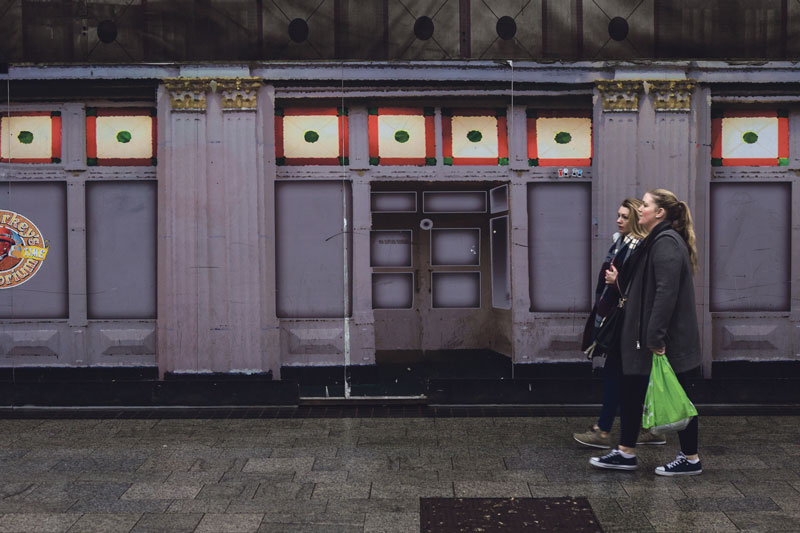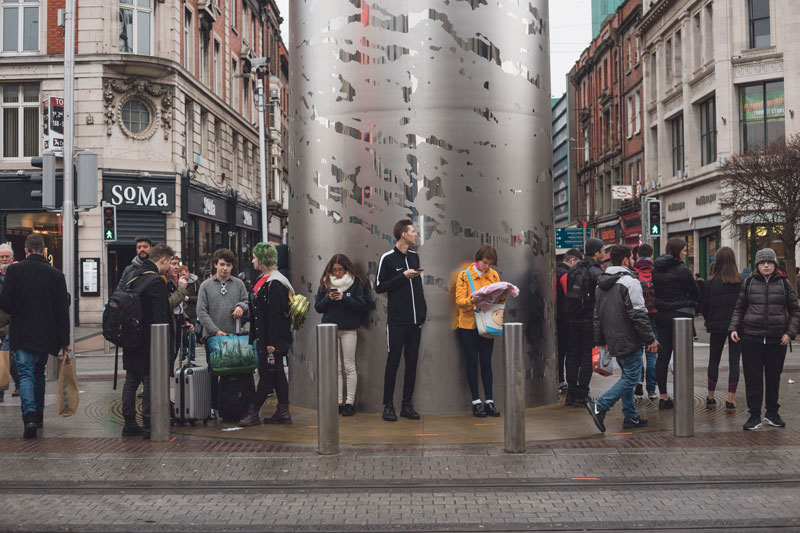What comes to mind when we think about O’Connell Street?
For most Dubliners, O’Connell St is a 500-metre long, 46-metre wide stretch of sleazy pubs, run down arcade emporiums, souvenir shops, fast food chains, convenience shops, with the odd government building thrown into the mix. Just walking down it can be a struggle, as you must swerve to avoid the hoards of yellow and green jackets waving leaflets at you as they desperately try to sign you up for “Dublin’s best sightseeing tour”. O’Connell St’s main claim to fame, the Spire, is far from being a source of local pride and hit peak utility in December 2015, when Dublin City Council lit it up to resemble a lightsaber in celebration of the premier of Star Wars: The Force Awakens.
In the midst of this bric-a-brac, statues of great Irish heroes, from Charles Stewart Parnell to James “Big Jim” Larkin, sit along the middle section of the street. They cast a stoney gaze upon the mess we have made of what was once considered to be comparable to the Champs-Élysées. However, as the new and improved Luas line now snakes its way through Dublin’s inner city, it seems like the perfect time to reflect upon the history of O’Connell St, long before it fell into decline. As for the future, one can’t help but wonder whether there is a future for the once-loved street.
The street lacks confidence in itself
In the 17th century, O’Connell St was but a narrow street designed by Henry Moore, the Earl of Drogheda. In 1714, Luke Gardiner, a wealthy banker and property speculator acquired the lands it encompassed and in 1749 he began to develop it as Sackville Mall, a Georgian-inspired residential area that would go on to boast some of the beautiful houses in the city. Under the tutelage of Dublin’s “Wide Street Commission”, the then-named “Sackville Street” was widened, making it the first “boulevard” street on the British Isles and predating London’s Regent St, Georges-Eugène Haussmann’s Parisian renovations and the development of Barcelona’s grid network. In 1784, the commission passed a resolution to extend Sackville St down towards the River Liffey and plans for a new bridge linking it to the south bank were set in motion. From 1795, Carlisle Bridge – now O’Connell Bridge – linked across the river and Sackville St went from being a self-contained residential quarter to a major thoroughfare.
Throughout the second half of the 18th century, Sackville St residences had attracted aristocratic investment, in order to provide townhouses for members of parliament. It remained a prime residential location until the Act of Union in 1800, when the dissolution of the Irish parliament and the transfer of legislative powers to London led to the ruling class residents of the streets to pack up their bags and move to London. The decline in Sackville St’s population accelerated in the 19th century as the advent of the railways saw members of the merchant and professional classes move to the suburbs and choose the lives of commuters.
And so began its first change – from a residential to a commercial area, as shops began to migrate to the street. By 1805, it was home to over 30 businesses as well as three hotels.
With the turn of the 19th century came the appearance of two of O’Connell St’s iconic monuments – the General Post Office (GPO) and Nelson’s Pillar. After the 1916 Rising, which had destroyed much of O’Connell St, an extensive debate ensued about how to redevelop the ruins.

The most prominent architects of the time saw the destruction as an opportunity to rebuild O’Connell St for the better and reverse the damage caused by both the fighting and the pre-1916 architectural neglect. Leading architect RM Butler believed that the future O’Connell St should house prestigious public buildings of national importance, thus restoring it to its former glory. “It has to be reconstructed, and therein lies a great opportunity”, he once said. If his list is impressive – he named a Gallery of Modern Art, a School for Progressive Art and hall for housing an organ – it’s more the shame these buildings never got added to O’Connell St.
After the Civil War in 1922, Horace T O’Rourke, the City Architect at the time, was determined to restore architectural integrity to O’Connell Street once and for all: “There is at present no cohesion and buildings jostle shoulders with one another which is mutually detrimental. A modest design is overshadowed by a more exuberant one”, he said.
Although O’Rourke and Butler’s unified street schemes were not achieved, much of O’Connell Street was rebuilt during the 1920s and 1930s. Many pre-war gems were re-established. These mostly consisted of hotels, department stores like the famous Clery’s, and cinemas like Carlton Cinema and the Savoy.
For many years, O’Connell St’s cinemas were at the heart of Dublin’s social life, but like most city-centre cinemas, they suffered a sharp decline in attendance during the 1980s. The demolition of the Metropole and the Capitol in 1973 – the grounds of which are currently occupied by Penneys, marked a point of no return, and O’Connell St started to slowly fade from its former glory.
Throughout the 1970s, as planning power fell into the hands of property speculators and developers, many more Victorian and 1920s buildings were demolished and replaced with lifeless grey blocks. Up until the end of the 20th Century, entertainment and fast-food outlets mushroomed along the street, rendering the former elegant boulevard a haven for flashing neon lights and cafes offering us their greasy wares.
When Nelson’s Pillar was still there, you could walk to the top and there was a viewing platform
Speaking to The University Times, Gary Gannon, the Social Democrats Councillor for North Dublin Inner City, thinks that “the main issue concerning O’Connell Street at the moment are the aesthetics, which are fairly depressing”.
“The street lacks confidence in itself”, he says.
In 1998, Dublin City Council launched the “O’Connell Street Area Integrated Plan”. This plan included building projects, traffic management and the creation of an improved environment for pedestrians.
Since then, a huge amount of effort has been put into revitalizing the O’Connell St area by making pavements wider, laying down Luas tracks and planting trees. Many Dubliners see the Luas cross-city as a starting point for a new and improved O’Connell Street, believing that it will give the area a well needed boost. But not everyone shares this opinion. Talking to passers by, including the newspapermen who still stand proudly on the street, the new Luas promises much, but delivers less.
Despite all the changes it has been through in recent years, little effort has been put into conserving significant historical buildings. Indeed, very few buildings of historical importance remain, with the exception of the GPO and the Georgian splendour of 42 O’Connell St. Even the infamous Clery’s Department Store has been on standby since it closed unexpectedly in 2015, leaving 460 people without jobs.
How can we make O’Connell St a place to go to enjoy spending time, rather than simply the quickest way to cross the Liffey? Widening footpaths and planting trees won’t make more people want to walk there if the buildings are falling apart and have nothing interesting to offer passersby. Perhaps the solution lies in the development of mix-use buildings, by restoring residential use of the upper floors and encouraging small businesses to set up shop on the lower floors rather than allowing commercial giants like Penneys and Dr. Quirkey’s Emporium to take over entire buildings. In December 2016, planning permission was granted to Natrium for a redevelopment project of Clery’s Department store, as it currently stands. The new complex would include a lobby, a 176-room boutique hotel, retail and office space, as well as a new rooftop terrace with a viewing deck over O’Connell Street. Could this facelift be a starting point for a new and improved O’Connell Street?
Ciara O’Halloran, who works at the GPO museum, thinks that re-opening Clery’s would be a great place to start. Speaking to The University Times, she says: “It would be lovely if Clery’s opened again. As a department store, or as anything else really. I liked the plans for the rooftop bar. You’d get a lovely view over Dublin. When Nelson’s Pillar was still there, you could walk to the top and there was a viewing platform. The pillar has actually been gone since 1966, so a lot of people never got to experience that kind of view. If Clery’s opened up its rooftop, you could have that viewing platform again that loads of people used to talk about.”
For Gannon, “the arrival of the Luas cross-city and plans for a city library on Parnell St should give it a confidence boost”.
Gannon is optimistic: “The situation has improved in recent years with members of the public standing up and demanding that the main street of our city looks good. Up until recently nothing has been stopping developers from building arcades and emporiums as they please, there have been no real restrictions. But this will change as more people stand up to it.”
If one thing is certain, O’Connell St needs to dust itself down and pick itself up if something major is to be done. If the problem is deep rooted, we’ll need creative answers to return Dublin’s boulevard to its former glory.







